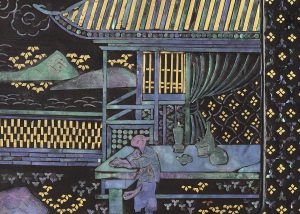Friday, March.10, 4:30 to 6:30pm, CWAC156
Action and Enaction: Cities, Tombs, Paintings
Jonathan Hay
Ailsa Mellon Bruce Professor of Fine Arts, the Institute of Fine Arts, NYU
Please notice that this workshop will be conducted in the format of a seminar with a 10-15 minute introduction by Prof. Hay. Please read following three readings and prepare for some questions in advance.
The three articles are:
“The Reproductive Hand” (2013)
https://drive.google.com/file/d/0BzfO9iB-iLhAOHpZcWJjYXV5a1E/view
“Seeing through Dead Eyes: How Early Tang Tombs Staged the afterlife”(2014)
https://drive.google.com/file/u/1/d/0BzfO9iB-iLhAY2NpcVBreGUtZzA/view?usp=drive_web
“Green Beijing: Ecologies of Movement in the New Capital C. 1450.” (2016)
https://drive.google.com/file/d/0BzfO9iB-iLhAWHVqaWdxSi1USVk/view
“I have selected for discussion three texts on different aspects of Chinese art, none of which is long and two of which are quite short. The longest, the research article “Seeing through Dead Eyes,” proposes a way of approaching tomb art that would supplement Wu Hung’s highly developed methods. The article explores the hypothesis that tomb building and tomb decoration at the beginning of the eighth century C.E. can be understood partly as a technology for the creation of afterlife choices by the soul of the deceased. The technology transformed the enclosed architectural space of the tomb into a vast residential compound with a multitude of possibilities of movement that extended even to visits from one afterlife residence to another. At the workshop, I will develop a point not discussed in the article itself: that this technology reflected an aristocratic view of life as the possibility of choices, in opposition to the absence of choice in imprisonment, servitude, and slavery. The theoretical essay, “The Reproductive Hand,” develops the theme of technology along different lines in order to understand better the practice of replication of paintings, especially during the period prior to the fifteenth century. I argue that the production of replicas is best understood as a cyborg technology in which the human practitioner effectively made himself into a machine. “Seeing through Dead Eyes” makes the theoretical argument that the concept of representation, which has long dominated art historical interpretation, is incomplete. When the central question of art history shifts from “What does the artwork mean?” to “How does the artwork make sense?” (alternatively, “What does the artwork do?”), it becomes necessary to balance representation with a separate concept of enactment. “The Reproductive Hand” extends the concept of enactment to include reenactment.
In a separate direction, the article “Green Beijing” sketches out a method for analyzing a city (Beijing ca. 1450) in art historical terms. More obviously than a tomb or a painting, a city is in constant movement, reconfiguring itself from moment to moment. And to a greater degree than a tomb or a painting, a city coordinates multiple elements. How can one do justice to this movement and multiplicity? The article argues for the usefulness of two interelated concepts, situation and scape, both of which have a counterpart in the Chinese concept of shi. As I use the terms in this article and elsewhere, situation is the interpretative counterpart to the epistemological concept of scape.
My practice as an art historian has been to multiply theoretical approaches and areas of inquiry without worrying too much about intersections and convergences. Nonetheless these occur. One could discuss the early eighth-century tombs or the pre-fifteenth century paintings in terms of situation and scape, just as one could discuss fifteenth-century Beijing in terms of technologies of enactment and reenactment. If you find it useful, we can do so during the workshop.”
Friday, March.10, 4:30 to 6:30pm, CWAC156
